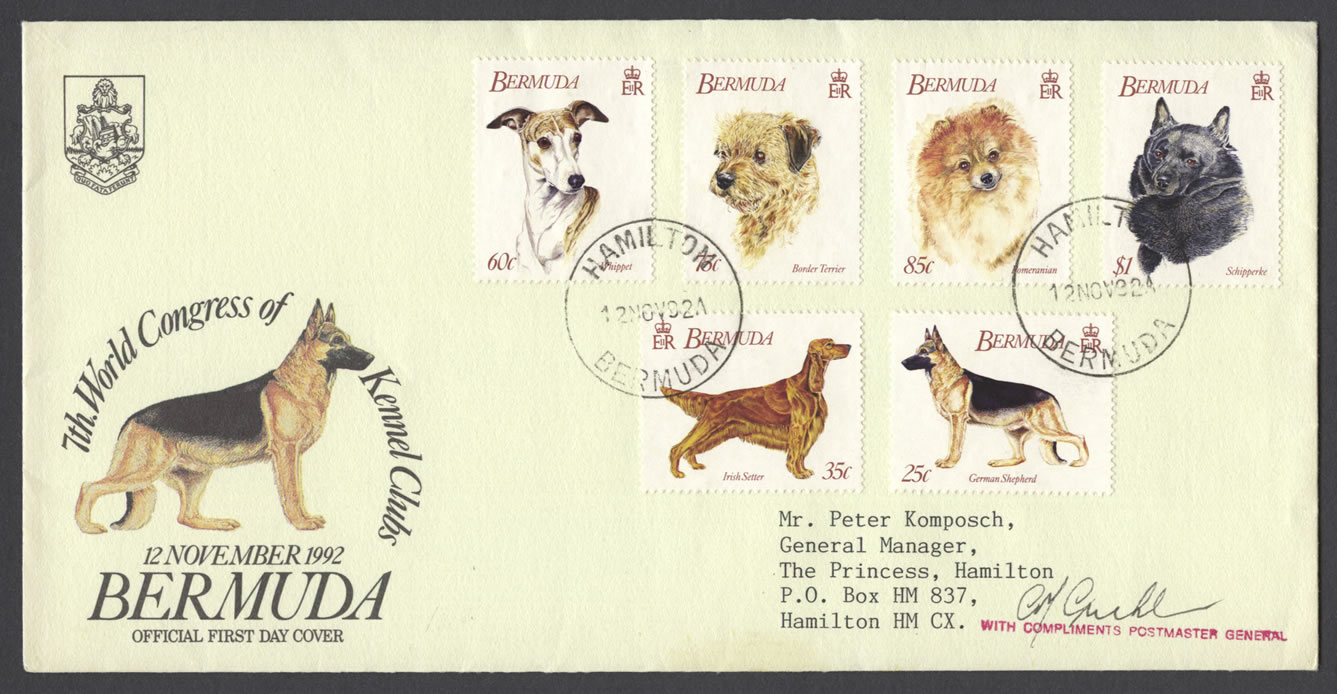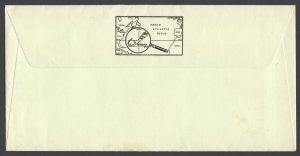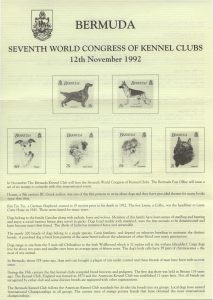Your basket is currently empty!

1992 7th World Congress of Kennel Clubs
A dog themed commemorative set
Date: 12th November 1992
Stamps: 25c German Shepherd; 35c Irish Setter; 60c Whippet; 75c Border Terrier; 85c Pomeranian; $1 Schipperke
Official First Day Cover
Cachet: 7th World Congress of Kennel Clubs / 12 November 1992 / OFFICIAL FIRST DAY COVER
CDS: HAMILTON BERMUDA 12NOV92A
Address: Mr. Peter Komposch, General Manager, The Princess, Hamilton P.O. Box HM 837, Hamilton HM CX
Signed: Unknown, WITH COMPLIMENTS POSTMASTER GENERAL

Liner
BERMUDA SEVENTH WORLD CONGRESS OF KENNEL CLUBS
12th November 1992
In November The Bermuda Kennel Club will host the Seventh World Congress of Kennel Clubs. The Bermuda Post Office will issue a set of six stamps to coincide with this international event.
Homer, a 9th century BC Greek author, was one of the first persons to write about dogs and they have provided themes for many books since that time.
Rin Tin Tin, a German Shepherd, starred in 19 movies prior to his death in 1932. The first Lassie, a Collie, was the headliner in Lassie Come Home in 1942. These series lasted for many years.
Dogs belong to the family Canidae along with jackals, foxes and wolves. Members of this family have keen senses of smelling and hearing and enjoy a social instinct hence they travel in packs. Dogs bond readily with mankind, were the first animals to be domesticated and have become man’s best friend. The dhole of India has remained fierce and untamable.
The nearly 200 breeds of dogs belong to a single species, Canis familiaris, and depend on selective breeding to maintain the distinct breeds. A purebred dog is bred from parents of the same breed without the admixture of other blood over many generations.
Dogs range in size from the 5 inch tall Chihuahua to the Irish Wolfhound which is 32 inches tall at the withers (shoulder). Large dogs live for about ten years and smaller ones have an average span of fifteen years. The dog’s body cell have 39 pairs of chromosomes – the most of any animal.
In Bermuda, about 375 years ago, dog and cats brought a plague of rats under control and these friends of man have been with us ever since.
During the 19th century the first kennel clubs compiled breed histories and pedigrees. The first dog show was held in Britain 133 years ago. The Kennel Club, England was formed in 1873 and the American Kennel Club was established 11 years later. Not all breeds are recognized by either club and some distinct breed are registered with other organizations.
The Bermuda Kennel Club follows the American Kennel Club standards but divides the breeds into six groups. Local dogs have earned International Championships in all groups. The current issue of stamps portray breeds that have obtained the most international championships.
THE WORKING GROUP
Some dogs in this group were bred for herding and other chores around the farm. Others were bred for guard duty and a smaller number of breeds were used in the Arctic and Antarctic region to pull sleds.
25c The German Shepherd
The German Shepherd is probably the most versatile working dog in the group. It is intelligent and very sound in body and mind. It appears elegant and has a certain aura of nobility. This strong, agile and well balanced animal which is longer than tall originated in Germany. With an ideal height of 23 to 25 inche and its fearless appearance, it emanates self-confidence with every movement.
THE SPORTING GROUP
Dogs in this group were bred to hunt, locate and retrieve game birds. They are primarily gun-dogs or bird-dogs. The modern pointers and setter have some hound blood in their pedigree. Even though they were bred for hunting they make excellent pets.
35c The Irish Setter
The Irish Setter, sometimes called the Red Setter, was originally used for hunting. It has a mixture of many bloods, the precise nature and dates when each was combined is not known. The Irish Setter is an active, aristocratic bird-dog, very rich red in colour, substantial yet elegant in stature. The dog has a straight, fine glossy coat, longer on the ears, chest, tail and back of legs. In the home, the Irish Setter is a good-natured, trainable companion.
THE HOUND GROUP
The hounds were originally bred to hunt all game except birds and are in the main scent hounds and sight hounds. The group includes Basenji, Beagle, Dachshund, Harrier, Rhodesian Ridgeback, Saluki and Whippet.
60c The Whippet
The Whippet, some believe, to be a descendant of the Pharaoh Hound which was brought to Great Britain in 55 BC. Others believe the dog to be a cross between the Italian Greyhound and the Terrier. Today the Whippet enjoys its reputation as a family pet and companion. It is elegant, very neat in appearance and easy to maintain.
THE TERRIER GROUP
The Terrier were developed in many regions of the world to attack vermin living in the earth (fr. terre). Members of this group are sturdy, active and of medium size.
75c The Border Terrier
A hard-working terrier used originally to control the fox population in the north of England. It possibly derived its name in 1880 when the breed was a favourite for hunting with the Border Foxhound. The dog is able to run with the hounds all day if necessary. It is very alert, active, agile and capable of squeezing through the smallest openings.
THE TOY GROUP
This group brings together small dogs from all over the world. Some are small versions of larger breeds with their own normal shape and proportion while others have short flat nose.
85c The Pomeranian
The ‘Pom’ is from the Spitz family of northern breeds formerly found in the Arctic Circle. This breed is very distinctive with its small pricked ears, pointed muzzle and mane of hair around its entire neck with a ‘plumed’ tail carried over its back. The breed became popular after Queen Victoria took int rest in Poms and exhibited them at many dog shows.
THE NON-SPORTING GROUP
This group contains show dogs and tho e not classified in the other five groups. This group includes Boston Terrier, Bulldog, Chow Chow, Dalmation, Keeshond, Lhasa Apso, Poodle and Schipperke.
$1 The Schipperke
Some believe the Schipperke to be the oldest pure-bred dog in Europe. The origin of the breed is shrouded in mystery. The name comes from the Flemish word ‘Schip’, meaning boat. The Schip has a short, chubby body with its rear slightly smaller than the foreparts. The head is fox-like with a questioning expression.
With kind acknowledgements to:
Liner text: K. Ed Kelly and Michael Defonte
TECHNICAL INFORMATION
Designer: Jacqueline Murray-Hall
Borders: Derek Miller
Printer: Joh Enschede, Holland
Process: Lithography
Stamp size: 30.56 mm x 38.00 mm
Pane: 50 (2 x 25)
Perforation: 13.75 per 2 cms
Paper: CA Spiral Watermarked
Values: 25c, 35c, 60c, 75c, 85c, $1
Release date: 12 November 1992
by


Leave a Reply
You must be logged in to post a comment.